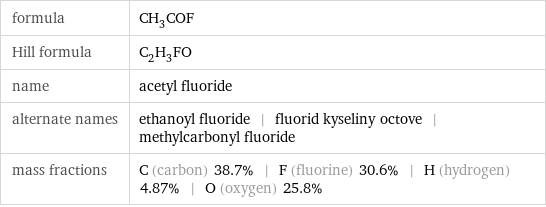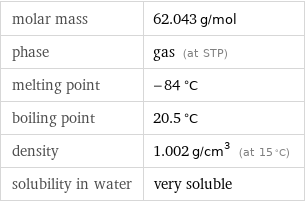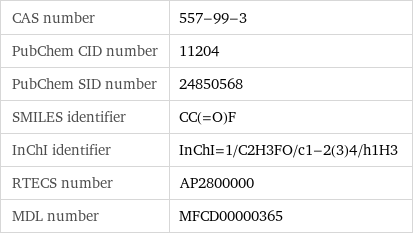Input interpretation

acetyl fluoride
Chemical names and formulas

formula | CH_3COF Hill formula | C_2H_3FO name | acetyl fluoride alternate names | ethanoyl fluoride | fluorid kyseliny octove | methylcarbonyl fluoride mass fractions | C (carbon) 38.7% | F (fluorine) 30.6% | H (hydrogen) 4.87% | O (oxygen) 25.8%
Lewis structure

Draw the Lewis structure of acetyl fluoride. Start by drawing the overall structure of the molecule, ignoring potential double and triple bonds: Count the total valence electrons of the carbon (n_C, val = 4), fluorine (n_F, val = 7), hydrogen (n_H, val = 1), and oxygen (n_O, val = 6) atoms: 2 n_C, val + n_F, val + 3 n_H, val + n_O, val = 24 Calculate the number of electrons needed to completely fill the valence shells for carbon (n_C, full = 8), fluorine (n_F, full = 8), hydrogen (n_H, full = 2), and oxygen (n_O, full = 8): 2 n_C, full + n_F, full + 3 n_H, full + n_O, full = 38 Subtracting these two numbers shows that 38 - 24 = 14 bonding electrons are needed. Each bond has two electrons, so in addition to the 6 bonds already present in the diagram add 1 bond. To minimize formal charge oxygen wants 2 bonds and carbon wants 4 bonds. Identify the atoms that want additional bonds and the number of electrons remaining on each atom: Fill in the 1 bond by pairing electrons between adjacent highlighted atoms: Answer: | |
3D structure

3D structure
Basic properties

molar mass | 62.043 g/mol phase | gas (at STP) melting point | -84 °C boiling point | 20.5 °C density | 1.002 g/cm^3 (at 15 °C) solubility in water | very soluble
Units

Gas properties (at STP)

density | 1.002 g/cm^3 (at 15 °C) molar volume | 61.92 cm^3/mol
Units

Thermodynamic properties

specific heat of formation Δ_fH° | gas | -7.126 kJ/g molar heat of formation Δ_fH° | gas | -442.1 kJ/mol (at STP)
Chemical identifiers

CAS number | 557-99-3 PubChem CID number | 11204 PubChem SID number | 24850568 SMILES identifier | CC(=O)F InChI identifier | InChI=1/C2H3FO/c1-2(3)4/h1H3 RTECS number | AP2800000 MDL number | MFCD00000365
Safety properties

flash point | -15 °C

DOT hazard class | 8 DOT numbers | 3265
Toxicity properties

RTECS classes | other